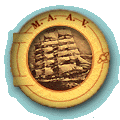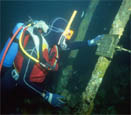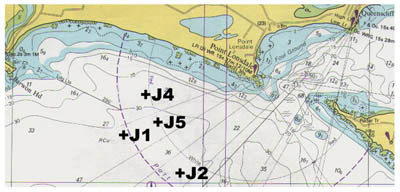|
|

|
|||||||||
|

|
In 1989 the MAAV commenced a project on the wrecks of the six RAN J Class submarines which were hulked between 1923-30. An interim report on the history of the submarines was published by project leader, Gary Smith, in the AIMA Bulletin 1990, Volume 14, No. 1.(Available through AIMA). See original J Class Submarine history version here.
Two of these submarines are lying inside Port Phillip, J3 at Swan Island and J7 at Sandringham, and four are situated in the ships' graveyard outside the Heads, ranging in depth from 27 metres to 41 metres. They are J1, J2, J4, and J5. J1 was scuttled 26 May 1926, J5 on 31 May-1 June 1926, J2 on 4 June 1926, and J4 one year later on 28 May 1927.
- 130 Foot Broken Submarine (39.6 metres)
The first J class submarine to be located was found by the Geelong Skindivers Club on 10 February 1974. - 120 Foot Intact Submarine (36.6 metres)
The second J class submarine to be located was found by the Geelong Skindivers Club on 4 May 1974. - 90 Foot Broken Submarine (27.4 metres)
The third J class submarine to be located was found by the Melbourne Bottom Scratchers Club about 1982. - 125 Foot New Deep Intact Submarine (38.1 metres)
The final J class submarine to be located was found by MAAV member Frank Derksen, Marteen Vanetie and another diver in October 1984.
As part of its project the MAAV determined to individually identify and accurately position each of the graveyard submarines, therefore enabling each to be interpreted according to its individual history.
Early research indicated that the four submarines were identical in dimensions and layout, but this was contradicted in a report received from the Deputy Chief Naval Architect, British Ministry of Defence.
The report said that a Royal Navy drawing placed the J class into two groups of J1-4 and J5-7, and that the bridge of J7 was moved 60 feet (18.3m) aft compared to J5-6. The plan showed a difference in overall length between the two groups, with J5-7 at 274 feet 9 inches (83.74m) being 9 inches (23cm) shorter than J1-4 which were 275 feet 6 inches (83.97m). Obviously the project the project team did not consider measuring the hulls at 30 plus metres to find this small difference. Another difference noted was that J1 was fitted with arrangements for discharging depth charges, notably a cylindrical receptacle aft with watertight doors. But it was found that the depth charges were dropped out of the underside of the hull, which happens to be what all the submarines are sitting on.
Fortunately a photograph held by Latrobe Library shows the four Graveyard submarines during a visit to Hobart in Jan-Feb 1921. The submarines are from left to right , J2, J4, J1, and J5. The photo shows that J1 has a different bridge construction to the others, and that each submarine has a distinctive bow ring. Site inspections were then conducted to investigate these differences, and the findings led to a positive identification of the vessels.

|
J1 Submarine
It was already known from earlier dives on the submarines that the 125 foot new deep intact submarine had the unusual bridge structure, therefore it has been identified as J1.
J5 Submarine
The bow ring of the 120 foot intact submarine was checked on the afternoon of 29 August 1993 by Jim Anderson and Terry Arnott. The measurements which were taken prove the submarine to be the J5. This was also confirmed by on-site observation of side struts on the bow ring which were not noticed on the photograph until later.
J4 Submarine
The bow ring of the 90 foot submarine was checked on the evening of 29 August 1993 by Jim Anderson and Terry Arnott. The photograph of J4 shows the ring at the very tip of the bow, and the measurements which were taken to prove the submarine to be the J4.
It was wagered that the 90 foot submarine would prove to be J4 as it was the odd sub out, sitting in less than 30 metres and scuttled one year after the others.
J2 Submarine With the identification of the older submarines completed, the 130 foot broken submarine can only be the J2. Nevertheless the identification will be further confirmed by an on-site inspection which will take place shortly. J2 has a rather unusual bow ring which can be seen in the photograph.

|
- J1: 125 Foot New Deep Intact Submarine (38.1 metres)
Latitude: 38 degrees 19.06 minutes
Longitude: 144 degrees 33. 18 minutes - J2: 130 Foot Broken Submarine (39.6 metres)
Latitude: 38 degrees 18.91 minutes
Longitude: 144 degrees 34.73 minutes - J4: 90 Foot Broken Submarine (27.4 metres)
Latitude: 38 degrees 18.06 minutes
Longitude: 144 degrees 33.73 minutes - J5: 120 Foot Intact Submarine (36.6 metres)
Latitude: 38 degrees 18.75 minutes
Longitude: 144 degrees 34.03 minutes
- Do you have any comments or questions regarding the J Class Submarine project report?
- If you have dived on any of the J Class Submarines have you any comments concerning the site?
- Do you have any information / photographs historical or otherwise which you believe may be useful to the MAAV for inclusion in the project report?
- Full credit will be given to any material if published.